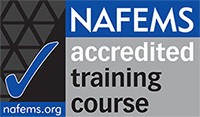Understanding Solid Mechanics: Applied Stress Analysis
This course aims to provide an understanding of the calculations required to determine the internal forces and stress distributions that correspond to the external loads applied on different structures utilised for their efficiency under certain conditions.
The course deals with beams that support bending forces acting along their length, shells and cylinders that support normal forces acting on their surfaces and shafts that support torsional forces.
Each session is a building block - over the four weeks, you will cover:
- Understanding Stresses in Beams
- Understanding Stresses in Thick Cylinders
- Understanding Stresses in Shells
- Understanding Shear Stresses and Torsion of Shafts
The course covers these topics in a concise and practical manner. Unlike traditional university courses, this course avoids lengthy mathematical derivations and highlights many practical examples to illustrate the application of solid mechanic theories in modelling and analysing engineering structures. Where possible, exercises that can be done by hand are included so that attendees can test their knowledge. Full solutions will be provided within a few weeks of completing the course.
Who should attend?
- Engineers and designers wishing to understand the background to solid mechanics in order to improve their analysis and simulation capacity.
- Engineers looking to refresh and improve their knowledge in solid mechanics.
The course is completely code independent.
Course Process and Details
This is a 4-session online training course, with each session lasting approximately 2 hours, depending on homework submissions, questions & discussions.
You can attend the sessions live, and/or stream on demand. For additional info on telephony charges please email e-learning @ nafems.org .
A full set of notes in PDF format will be available for download.
Personal passwords are provided to allow you to access e-learning backup material via our discussion forum. Reading lists, homework submissions and supplementary information are all available via the discussion forum.
To get the most out of the course, participation in forum discussions is very much encouraged. Typically the forum remains open for 4 weeks after the last live session, giving you plenty of time to catch up with homework, review and ask questions.
Note: homework is purely voluntary
Course Program
This set of courses is important for designers and engineers who wish to gain a good understanding of the basic solid mechanics: Session 1 - Understanding Stresses in Beams Session 2 - Understanding Stresses in Thick Cylinders Session 3 - Understanding Stresses in Shells Session 4 - Understanding Shear Stresses and Torsion of Shafts In order to calculate the capacity of a component we need to understand the internal forces acting inside the body that correspond to those acting externally. From these internal forces we calculate the internal stresses distribution taking into account that different components or structures develop different stress distributions depending on their geometry, external loading and desired behaviour. Typically beams are long slender structures with arbitrary cross-section that are used to withstand bending forces acting along their length (session 1), thick cylinders are a specific form of surface structures designed to withstand pressure forces acting on their internal or external surfaces (session 2) while shells are considered general curved surface structures that withstand surface forces (session 3). Structural shafts of circular and non-circular cross-sections are typically used to withstand torsion via shear stress (session 4). The main objectives of the course is: - To provide delegates with a good understanding of solid mechanics and basic theories that are widely used in engineering design, analysis and simulation
- To present many practical examples of engineering applications to reinforce the solid mechanics theories.
|







